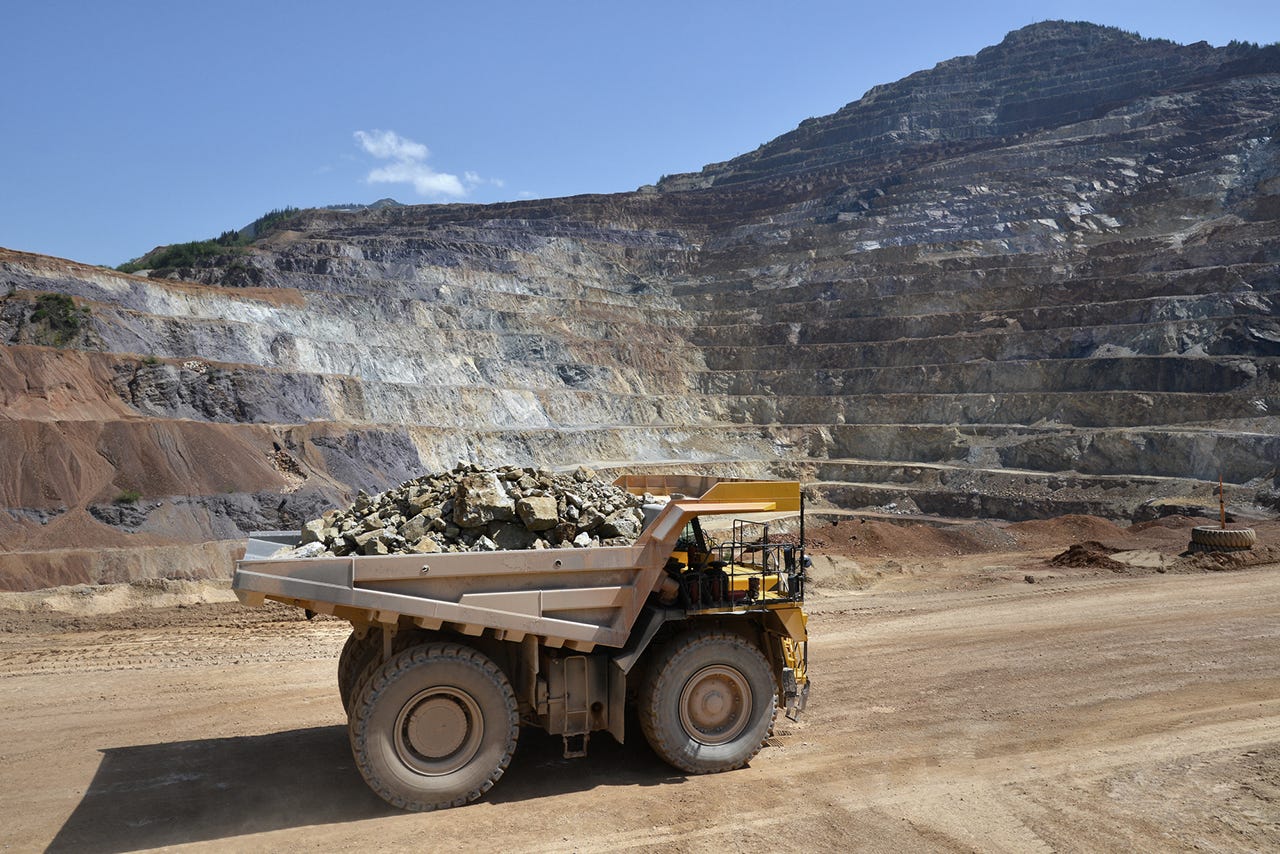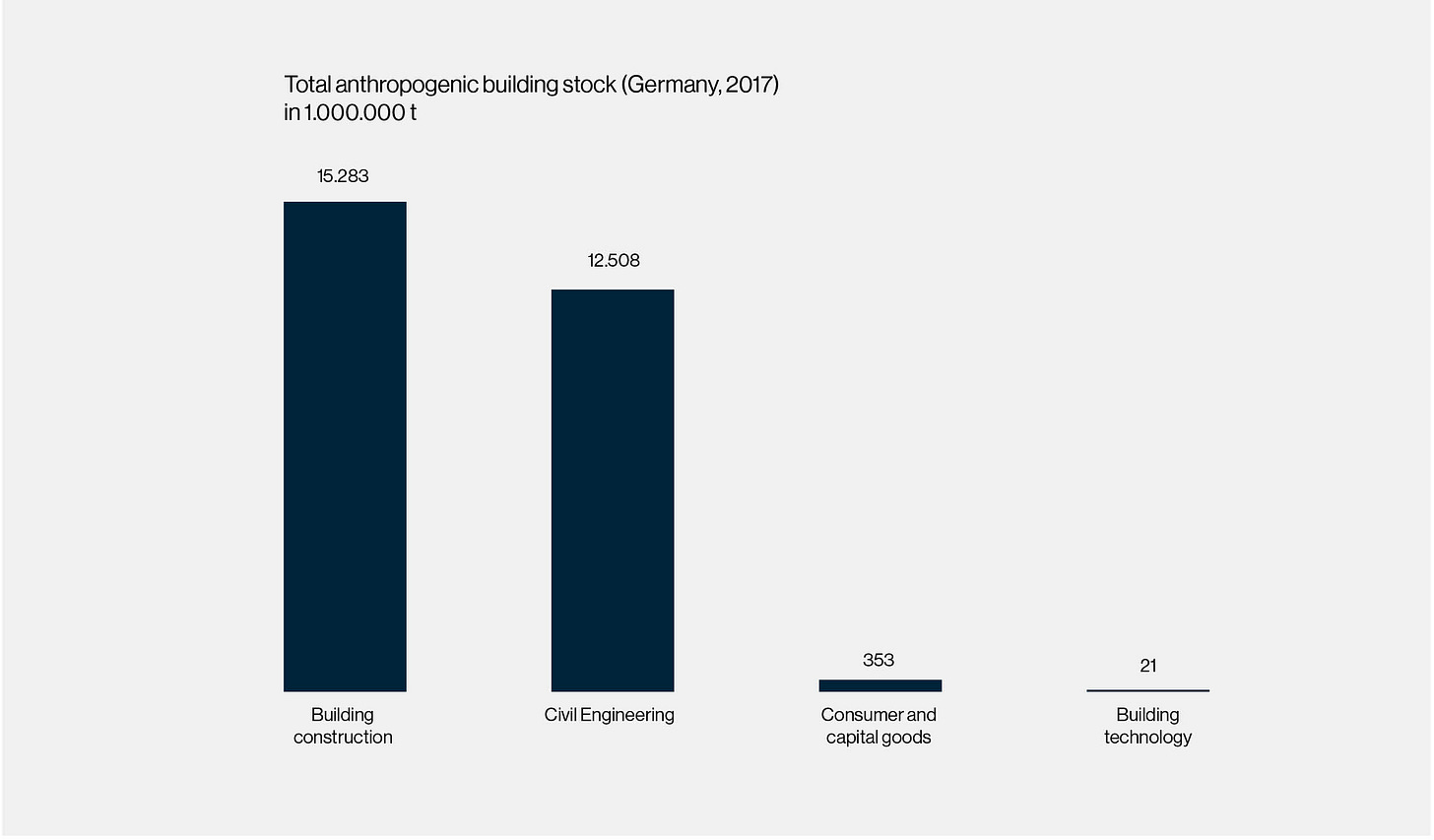The City as Resource
Towards a resource-conscious approach
For the past decades, the discourse on sustainable architecture and urbanism has focused on the operations of buildings and cities: how to efficiently heat and cool our buildings, sustainably transport ourselves, and produce clean local energy to provide these services – while largely overlooking the environmental impact of the construction of these buildings and cities.
Today, there is growing awareness of the vast amount of energy and resources used in the process of construction and their substantial share of buildings’ and cities’ environmental footprint. The construction industry is currently responsible for the largest share of the world’s total production of raw materials.1 The processes involved in excavating building materials and constructing new neighbourhoods and infrastructure consume natural resources that are vital to the world’s eco-systems. Furthermore, the ‘up-front’ carbon produced during construction accounts for a large and increasing share of buildings’ and infrastructures’ total environmental life-cycle burden.2

Over the past century, resource consumption and the environmental impact hereof by the construction industry has skyrocketed: we are using increasingly more floor space per capita,3 our cities are rapidly sprawling into open countryside,4 and the production of concrete and its associated carbon emissions have increased manifold.5 As we find ourselves in a climate crisis for which our industry is largely responsible, we must ask ourselves: How can we put this process in reverse? How can we use our resources more efficiently? And how can we produce buildings and cities that cause less damage to our planet?
The City as Resource
One way of responding to these challenges is by using the resources in the already built environment more expediently and efficiently. The reserves amassed in our cities in the form of buildings and infrastructure over the past century (up to 250 tonnes per capita, according to a mapping from the German Environmental Agency 6) form a great repository for future buildings and urban development.
By maximising the use of these vast resources through recycling, reuse, transformation, optimisation and so forth, we can substantially reduce the need for newbuild and reduce the adverse environmental impact associated with it. The potential of doing so is highlighted in several recent studies, pointing to the environmental advantages of reusing existing building stock rather than building new,7 as well as in the latest IPCC report which concludes that “the highest mitigation potential is within the retrofit of existing buildings.”8
Though there is a growing interest in these practices in the construction industry, the focus is often on the recycling of individual components for new buildings, despite the challenges of such practices: most of our existing buildings were not designed to be disassembled and require a significant amount of energy to do so. Also it is difficult to source the right quantities of specific components and materials at the right time.9

By contrast, reusing entire buildings and built structures directly on site through adaptive reuse (renovation, transformation, or adaptation) uses less energy and resources and is therefore more environmentally and financially beneficial. What is more, adaptive reuse offers an opportunity to make use of the social, cultural, and aesthetic resources embedded in the already built environment. This is something Cobe has experienced in projects such as Nordhavn, where transformed grain silos articulate the industrial legacy of the site while providing unique spatial features to the housing into which they are transformed.
While practices of adaptive reuse are not new – they have been around along as human kind 10 – they have gained increased traction in recent years. However, until now they have mainly centred on cultural heritage, often focusing on conversions for cultural purposes or small-scale projects. By scaling up these practices and implementing them more broadly and on a bigger urban scale – where major decisions are taken and the impact is greater – they could make a substantial contribution to a much-needed sustainable transformation of the construction industry.
Broader and larger scale adaptive reuse measures
So, how can we upscale practices of adaptive reuse? The initial research has identified four key areas that we will continue to explore and develop in the time ahead.
1. Change demolition and preservation practices to prolong the useful life of buildings and built structures. Statistics indicate that buildings’ life expectancy is decreasing whereas demolition rates are increasing.11 By observing and screening the existing building stock through the lens of climate change and resource scarcity, we can bolster an extended notion of ‘preservation value’ in which all buildings and built structures, not only those traditionally included by heritage criteria, are deemed worthy of preservation and reuse.
2. Reuse the built environment in its entirety, including all its elements, not only buildings, but also public spaces, infrastructure, land, and even entire urban environments. As studies show that half of the existing building mass and its embedded CO2 is kept in infrastructure, 12 exploring how to make better use of these material resources stowed below ground and in between buildings becomes critical. Reusing entire urban environments, including the land on which they stand, can also prevent urban sprawl into open countryside and the associated sealing of valuable soil.13
3. Optimise the use of the existing building stock and make better use of available floor space. Increasing reuse measures is not only about binary choices between demolition or preservation, but also one of how we get by with less and make better use of what we have. Each year we are effectively adding to the building stock and increasing the per capita use of floor space. However, much of the building stock is empty or underutilised at present. Vacancy rates are high, particularly in office buildings, which has only increased in the wake of the pandemic. By maximising the utilisation efficiency of the existing stock, we can reduce the amount of floor space each person uses and ultimately decrease the demand for newbuild.
4. Look beyond the post-industrial areas in our urban centres and re-evaluate the potential of geographic areas that have not traditionally been considered eligible for reuse practices. Up to now, much of the focus has been on urban post-industrial areas, but the potential is perhaps bigger elsewhere. Peripheral urban areas or even the countryside have higher per capita floor space utilisation, higher vacancy rates and more underutilised infrastructure than in urban centres and must therefore be included in discussions of reuse and optimisation of the existing building stock. This is increasingly relevant in a time when people seem to be moving away from urban centres.14
By exploring and investigating these topics we wish to develop an understanding of how we can make better use of the resources in the built environment, in the context of climate change. Hopefully, this can contribute to a dialogue on how to enable a sustainable transformation of the construction and planning industry - to emit less carbon, consume fewer resources, and cause less damage to our ecosystems.
References:
Fig. 1. Krausmann, F., Gingrich, S., Eisenmenger, N. et al.: Growth in global materials use, GDP and population during the 20th century. Ecological Economics, 2009. 68(10): pp. 2696–2705.
Fig. 2. Eberhardt L.C.M., Birgisdottir, H. & Birkved, M. (2019): Potential of Circular Economy in Sustainable Buildings. IOP Conf. Series: Materials Science and Engineering 471
Fig. 3. Schiller, G., Ortlepp, R., Krauß, N. et al. (2015): Mapping of the anthropogenic stock in Germany for optimizing the secondary raw material economy; (in German). In: UBA-TEXTE 83/15. German Environment Agency: Dessau-Roßlau.
Krausmann, F., Gingrich, S., Eisenmenger, N. et al.: Growth in global materials use, GDP and population during the 20th century. Ecological Economics, 2009. 68(10): pp. 2696–2705.
Röck, M., Ruschi Mendes Saade, M., Balouktsi, M. et al. (2019): Embodied GHG emissions of buildings – the hidden challenge for effective climate change mitigation, Applied Energy (258 114107).
Ellsworth-Krebs, K. (2020): Implications of declining household sizes and expectations of home comfort for domestic energy demand. Nat Energy 5, pp. 20–25.
Ritchie, A., Roser, M. & Rosado, P. (2020): CO₂ and Greenhouse Gas Emissions. Published online at OurWorldInData.org. Retrieved from: 'https://ourworldindata.org/co2-and-other-greenhouse-gas-emissions'.
Krausmann, F., Gingrich, S., Eisenmenger, N. et al.: Growth in global materials use, GDP and population during the 20th century. Ecological Economics, 2009. 68(10).
Ramboll (2020): Analyse af co2-udledning og totaløkonomi i renovering og nybyg. Copenhagen: Ramboll.
IPCC (2022): Climate Change 2022 – Mitigation of Climate Change. WMO & UNEP.
Hebel, D. (2020): 100% Ressource: Bauten als Rohstofflager. In Bahner, O., Böttger, M. & Holzberg, L. (Eds.) Sorge um den Bestand, Zehn Strategien für die Architektur. Berlin: Jovis.
Wong, L. (2017): Adaptive Reuse: Extending the Lives of Buildings. Basel: Birkhäuser.
Stollmann, J. (2014): Hands Off: Urban Mining! A Plea for the Re-evaluation of Substandard Housing In Hebel D.E., Wisniewska M. & Heisel, F. (Eds.) Building from Waste. Basel: Birkhäuser.
Schiller, G., Ortlepp, R., Krauß, N. et al. (2015): Mapping of the anthropogenic stock in Germany for optimizing the secondary raw material economy; (in German). In: UBA-TEXTE 83/15. German Environment Agency: Dessau-Roßlau.
European Commission (2016): Future Brief: No net land take by 2050? European Commission: Brussels.
Dam, P. S., (2022): København skraber bunden i ny undersøgelse – én gruppe flygter fra byen. Berlingske: Copenhagen.





